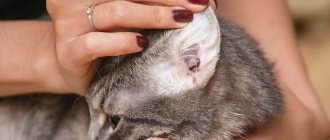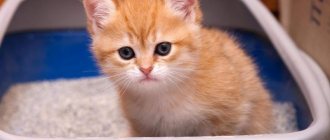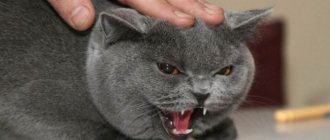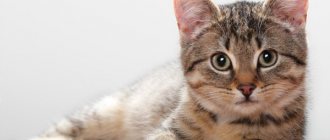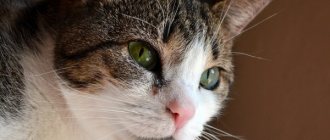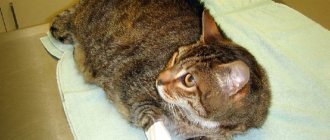- 2 First aid
Causes of foam and increased salivation in cats
Foaming from the mouth of a four-legged pet is usually associated with excessive saliva production. Often the causes of foamy vomiting are quite harmless, and it will not be difficult to identify them yourself at home. However, sometimes such a problem can arise due to a factor that seriously threatens the health and life of the pet. Pathological causes of foam coming out of the mouth in a cat must be promptly identified and eliminated.
Toxicosis during pregnancy
Like women, cats experience toxicosis during pregnancy. This painful condition is often accompanied by foam at the mouth. Typically, a pregnant pet produces foamy drool after eating or sleeping. If this happens after feeding, the stomach contents expelled by the cat may contain pieces of incompletely digested food. The awakened expectant mother vomits transparent foam. This is a normal phenomenon and does not require special measures. When the pet's toxicosis ends, it will disappear by itself.
Poisoning by poisonous plants
A cat, in search of the vitamins it needs, can chew any plant in the house or on the street. But among the many indoor flowers and garden plants planted in flowerpots, flower beds and growing freely on the site, there are also poisonous for pets, causing poisoning. Even Kalanchoe, a completely harmless flower, can have a negative impact on a pet’s heart, let alone plants that are more dangerous for a cat.
Common signs of poisoning by poisonous plants include:
- arrhythmia and rapid pulse;
- dilation or constriction of the pupils;
- diarrhea;
- trembling in the body.
What can be done in case of plant poisoning? You should immediately rinse your pet’s stomach with a weak solution of potassium permanganate or enterosgel (about 1 tablespoon).
Cases of poisoning in cats, despite all their caution, are not so rare. And most of the blame for what happened to pets rests, of course, on the pet owners
You must always follow the instructions when treating cats for parasites, isolate your pets in another room when baiting bedbugs with dichlorvos, put away all household chemicals, and do not give your pets expired food, spoiled food or mushrooms, the edibility of which is in doubt.
This article was prompted by a recent incident. My Chupacabra really loves grass, a special green grass that is sold in pet stores. And then one day I bought him the wrong grass.
Although, it would seem, how can a pet store sell some kind of different herb!
In the evening, Chupacabra was gnawing grass with pleasure, and at night strange sounds were heard. And in the morning I discovered several strange puddles on the floor - the Chupacabra was vomiting at night.
But since we are all accustomed to the fact that cats spit up their fur from time to time, especially if they are fluffy, I did not pay attention to this. And she went to work. And in the evening I found several more caustic puddles on the floor and a completely exhausted Chupacabra lying on the bed like a rag. The cat was clearly poisoned. But what could he have poisoned himself with?
Naturally, the newly acquired weed went into the trash, and the Chupacabra still had to be treated for several days. No one could have expected such a situation from simple cat grass.
When to start sounding the alarm
Vomiting blood in a cat: reasons, what to do
In addition to physiological reasons, there are situations when it is worth acting immediately so as not to aggravate the situation and give the animal a chance for a further healthy life. There are a number of pathological health problems that can cause cats to foam at the mouth.
Epilepsy
This disease is caused by a serious pathology of the brain. To identify epilepsy, you should know what its main symptoms are:
Epilepsy in a cat
Epileptic seizures in cats can occur with different frequency: in some - once a week, and in others - 1-2 times a year.
Attention! Sometimes the foamy growths may turn pink, a sign that the tongue or the outer part of the cheeks was bitten during the seizure.
Poisoning
The appearance of foamy formations can be caused by poisoning of the cat, for example, household chemicals, flower poisons, poor-quality food, or something else. Symptoms of poisoning are as follows:
- diarrhea;
- nausea and vomiting;
- complete apathy or, on the contrary, irritation;
- dilation of the pupils is observed;
- body temperature below 38 degrees;
- tachycardia;
- unsteady gait.
Plague
The scientific name of the disease is “panleukopenia”, and in common parlance it is feline distemper.
To recognize this disease, you should pay attention to the following symptoms:
- high body temperature, reaching 41-42 degrees;
- vomiting with foam, mucus or blood;
- urine becomes darker;
- one or both eyes water and purulent discharge occurs;
- the cat completely refuses water;
- frequent and intermittent breathing;
- The cat looks for a distant corner in the house, where it then lies for a long time.
For reference: contrary to popular belief, feline distemper is not dangerous to humans. Therefore, the animal owner can and should help the pet.
Infections
Infectious diseases can provoke foamy discharge from the mouth, and the worst among them is rabies.
The disease can be mild or severe. During a mild form, the animal becomes apathetic, afraid of light and refuses any food. In the acute form, there is excessive affection towards the owner, which gradually develops into aggression and attack. Also, the cat may eat inedible objects, the eyes become cloudy, the pupils are dilated, and saliva is released profusely.
Important! Rabies is dangerous to humans. If you have any suspicions, after being bitten by a cat with symptoms of the disease, you should immediately go to the hospital for qualified help. Once the virus has penetrated the nerve fibers, the process becomes irreversible.
Today there is no cure for rabies and therefore this disease ends in the death of the animal.
Gastrointestinal diseases
Foam formations can occur in the presence of gastritis, pancreatitis, enteritis, ulcers and other problems. Each of the diseases has its own symptoms, but common ones include constipation, diarrhea, flatulence, pain, complete lack of appetite, vomiting with blood, as well as deterioration in the appearance of the animal.
Gastrointestinal problems in animals
What is causing the problem?
Physiological reasons
Many veterinarians warn that with prolonged use of certain medications to treat pets, especially against helminths, adverse reactions may occur, including foamy saliva.
The release of foam from the mouth of a cat does not always signal a pathological condition. Sometimes some physiological factors can influence the appearance of a symptom, such as:
- Cat carrying kittens. During pregnancy, foamy saliva is often observed, which is caused by toxicosis. At a later stage, such symptoms may disappear on their own.
- Severe stress or fear. In this condition, the pet’s salivation increases and foam may appear.
- Ingestion of hairballs. A similar phenomenon is recorded in long-haired domestic animals during the molting period.
- Prolonged feeling of hunger. In this case, gastric juice is produced in large quantities and irritates the gastric mucosa. As a defensive reaction, the cat vomits with the release of gastric contents and air.
- Motion sickness in transport.
- Coming out of anesthesia after surgery, which may cause nausea and vomiting.
Probable diseases
A stressful situation experienced can manifest itself in this way in an animal.
White foam at the mouth of a cat can appear after he has eaten a frog, experienced severe stress, or has been seasick. In this case, no additional symptoms are observed. When foamy drool appears, and vomiting, diarrhea begins, an elevated temperature in the cat and other unpleasant symptoms are recorded, this may indicate the development of a pathological process. There are such deviations that cause foam to flow from the mouth:
- Stomatitis. This disease is characterized by the appearance of wounds on the oral mucosa.
- Problems with digestive function. If you take too much green grass, have a gastrointestinal infection, or have an intestinal obstruction, you may experience foam in the mouth area.
- Internal bleeding. In this case, the foamy saliva will have a pinkish or rich red color.
- Dysfunction of the liver and gallbladder.
- Heart failure. Symptoms may occur before a heart attack or during the disorder. To prevent the cat from dying, he needs help as soon as possible.
- Damage to the brain area of varying severity.
- Poisoning. If your pet has a lot of foam at the mouth, a similar reaction may occur to oral medications or after an injection. Signs occur if the animal has been bitten by a parasite or has eaten rat poison.
- Epilepsy. Foamy discharge from the mouth is a characteristic symptom of an epileptic seizure.
- Rabies. The disease is accompanied by excessive salivation, foam, and paralysis of the paws. With such a disorder, practically no medications alleviate its condition.
- Plague or panleukopenia.
Veterinarians note that foam at the mouth can occur when infected with helminths, while the advanced course is characterized by parasitic inclusions in the vomit and feces.
In what cases is the help of a veterinarian needed?
Foamy vomiting in a pet is not always a harmless phenomenon. In some cases, the speed of reaction of the owner of a cat that is vomiting foam determines its future fate and even its life.
Consultation with a veterinarian is required in the following situations:
- lethargy, apathy, sleep disturbance, lack of response to external stimuli, decreased motor activity;
- partial or complete loss of interest in food;
- indigestion (vomiting, diarrhea or constipation);
- foul odor and the appearance of ulcers in the mouth;
- foreign inclusions in foamy vomit (blood, bile, mucus);
- weight loss;
- signs of body dehydration (dehydration);
- rhinitis;
- photophobia;
- increased body temperature;
- epileptic seizures;
- muscle cramps, paralysis;
- greenish vomit;
- discharge from the eyes and nasal passages;
- icteric staining of the mucous membranes;
- incoordination of movements.
Share with friends!
Let's understand the reasons
There are many reasons why an adult cat or kitten foams. However, if this phenomenon is detected, it is important to make sure that the pet is healthy. You need to pay attention to other symptoms, monitor the animal and, if necessary, contact a veterinary clinic. Do not rush to do something without understanding the situation, and without the recommendation of a specialist.
So, foam can go if:
- this is the result of stress or severe fear;
- this is how severe pain often manifests itself;
- poisoning;
- when exposed to bitter substances, for example, often from bitter medicines;
- The cat cleanses the stomach of fur in this way;
- the animal has choked or there is a foreign object in the mouth;
- dental problems;
- gastrointestinal diseases (enteritis, hepatitis, etc.);
- viral diseases (calcivirosis);
- brain damage, for example, a blow, bruise;
- heart attack;
- sign of rabies.
Vomit color
In order to establish the cause, you need to pay attention to the color of the vomit. If your cat has white foam mixed with fur, then you don’t have to worry - this is a natural process of self-cleaning of the stomach. To prevent this from happening again, it is important to regularly brush your pet and remove hair, especially during shedding.
White foam can indicate an empty stomach, for example, this happens in the morning before breakfast if a cat or baby is hungry. But if vomiting white foam is repeated frequently, this may indicate a serious stomach illness; the animal should be shown to a doctor.
If the foam is green, then the cat may have simply eaten grass or produced too much bile. If it occurs frequently, it is a sign of infection. Frequent gagging and foaming cannot be considered harmless. It is important to remember that against the background of general weakness and apathy, this may be a symptom of plague or panleukopenia. It is important to do an analysis right away.
The discharge of white foam with blood cannot be ignored. If small clots of bright blood are visible, this may indicate an injury in the mouth or esophagus; the cat may have been injured or swallowed an object. If the foam is brown from blood, then the bleeding is internal, and your pet needs to be shown to a doctor immediately. This may be an injury to the walls of the stomach or an exacerbation of gastritis.
Vomiting foam with a yellow tint may indicate that bile has entered the stomach. The walls of the stomach react to this manifestation by vomiting. If the symptom is repeated more than once, then this is due to a chronic disease of the gallbladder, liver or intestines. This is often due to overfeeding the pet with fatty heavy foods and eggs. Sometimes this phenomenon is provoked by chemical additives from industrial feed. It is necessary to check these bodies.
Sorry, there are no surveys available at this time.
Common Causes of Halitosis
Very conditionally, the causes that cause halitosis in cats can be divided into four large subgroups. The owner is not always able to diagnose it on his own - sometimes the help of a veterinarian is required.
Diseases of the mouth and teeth
Dental diseases can be both serious and easily solvable conditions:
- Stomatitis and gingivitis are inflammatory processes of the gums, palate and inner surface of the cheeks.
- An abscess is a closed, encapsulated abscess formed as a result of the entry of a foreign body that provokes inflammation.
- Changing teeth in a kitten can cause bacterial growth and, as a result, a bad odor.
- Plaque and tartar can cause halitosis.
These problems are easily treated, especially at the initial stage. Plaque and tartar can be avoided through prevention, that is, regular brushing.
Diseases of the nasopharynx
Halitosis is a common accompaniment of polyps in the nasal passages. Once they are removed, the stink disappears.
Mustachioed friends also suffer from such human diseases as sinusitis and sinusitis. The symptoms are similar to a runny nose: discharge from the nose and eyes, frequent sneezing, and sometimes the animal’s temperature rises.
Viral diseases can also manifest themselves, which often cause the death of a pet. At the first alarming signs and lethargic state of your pet, do not be too lazy to go to the veterinarian.
Problems with internal organs
Diseases of internal organs are more common in older animals. Usually the stench occurs when there are problems in the gastrointestinal tract, tumors and neoplasms in the liver, stomach, lungs, etc.
Diabetes in older cats does not promote fresh breath, nor does reverse reflux or pneumonia. Severe conditions require mandatory treatment under the supervision of a specialist.
Parasite infestation
Even an animal that does not leave the apartment should be dewormed (that is, drive away worms). People can carry parasite larvae on their shoes, and if a cat likes to feast on fresh meat or raw river fish, worms can be waiting for it there too.
For individuals walking on the street, veterinarians set a deworming period once a quarter. It is enough to worm your pets once or twice a year, and always two weeks before the annual revaccination. This must be done, because if there are worms, the vaccination may not work or cause serious damage to the pet’s health.
Can vomiting be prevented?
To prevent vomiting you need to:
- periodically treat the cat for worms;
- balance the diet;
- think over the feeding regime;
- undergo a preventive veterinary examination annually and undergo routine vaccinations against infections.
If vomiting is caused by the accumulation of wool in the stomach, then special foods or pastes will help speed up its removal from the digestive tract.
It will not be possible to prevent the ingestion of wool, but you can reduce its entry into the stomach. This can be done with the help of combs, mitten brushes, and furminators.
What to do if your cat is foaming at the mouth?
Unfortunately, even a specialist without appropriate tests cannot always identify the exact etiology of a symptom.
In case of poisoning, the animal must be given a sorbent to drink. In case of severe intoxication, urgent qualified medical care is required.
If there is a suspicion of worms, it is not recommended to select anthelmintic drugs on your own. The doctor will select the optimal dosage and the most suitable medication.
During an attack of epilepsy, the animal is placed on its side, provided with an influx of fresh air, and waits for the end of the seizures. The attack usually does not last long - 5-7 minutes. After this, the cat needs to be taken to the clinic for diagnosis and treatment. Infectious diseases should not be treated on your own. Incorrectly selected medications and dosages will only worsen the situation. The animal requires examination by a specialist and possibly hospitalization.
Since the symptom is characteristic of many diseases and physiological processes, there are no accurate and effective recommendations on what to do in such cases. The most correct decision would be a visit to the veterinary clinic.
Diagnosis and treatment
When contacting a veterinary clinic, you need to provide the specialist with the following information:
- What did the cat feed, were there any changes in the diet.
- How often did vomiting occur?
- Are there any chronic diseases or infections in the animal that the owner is aware of?
This will help establish an accurate diagnosis and take the necessary measures.
Diagnosis of the pathological condition of a cat is as follows:
- analysis of the type and consistency of vomit;
- examination of the cat, analysis of the general condition;
- laboratory tests of blood, urine;
- Ultrasound of the abdominal cavity, kidneys.
The treatment regimen is selected depending on the established diagnosis. It includes drug therapy and measures to prevent dehydration.
During the treatment of vomiting in a cat, a special diet is necessary. Food should be semi-liquid. Feed your pet more often, in small portions. Meat should only be given boiled and chopped. After stabilization of the condition, the transition to the usual diet should be gradual.
Questions from a veterinarian to help make a diagnosis:
- diet for the entire time, over the last 2 days, were there any changes;
- presence of appetite;
- amount of vomit, what it consists of;
- chronic diseases.
Take the following tests:
- biochemical analysis of blood and urine;
- Ultrasound to analyze intestinal integrity;
- x-ray to exclude tumors and foreign objects;
- stool analysis for worms.
To understand what actually caused the vomiting, the doctor must find out some details from the owner:
- When the vomiting started.
- What has the cat been eating lately? Have there been any changes in his diet? How much did he eat?
- How often does vomiting occur?
- How much vomit comes out and its composition.
- Does the cat have any chronic or infectious diseases?
- How the animal eats and drinks.
- Cat behavior.
- Frequency of going to the toilet.
In addition, the doctor must examine the animal. Sometimes, to make a diagnosis, it is enough to obtain information from the pet owner and palpate the abdomen. If this is not enough, the doctor will order a urine and blood test.
Some clinics prefer to do a full range of diagnostic measures, which includes x-rays of the kidneys and ultrasound of the abdominal cavity.
Treatment depends entirely on the diagnosis. Mostly medications are prescribed, as well as measures aimed at preventing dehydration.
There are several treatment methods:
- If vomiting is caused by a malnutrition, then a change in diet and medications that restore the intestinal microflora will be prescribed.
- For gastritis, medications are also prescribed to help restore digestion.
- If the doctor discovers that the cat is infected with worms, then in addition to restoring the water-salt balance, antiparasitic drugs will be prescribed.
- In case of poisoning, the cat's stomach will be rinsed and appropriate medications will be prescribed to help remove toxins from the body.
- If vomiting is associated with a respiratory disease or with an inflammatory process, then the cause of vomiting will also be treated first.
- Frequent vomiting during pregnancy also requires therapeutic measures. Usually the animal is given IV drips with glucose and vitamins to support the body of the expectant mother and her unborn kittens.
- In case of renal failure, first of all, they try to normalize the functioning of this organ. To do this, the cat is put on a low-protein diet and prescribed medications that lower blood pressure.
- Vomiting during estrus is not treated, but only medications are prescribed to prevent the animal from dehydration. If a cat undergoes such a period and is constantly accompanied by vomiting and diarrhea, the veterinarian may suggest sterilization to save the animal from suffering and possible negative consequences.
The treatment strategy is to eliminate not only the signs of pathology, but also its causes. Therefore, the cat owner must understand in what cases and how he can help the cat on his own, and when it is necessary to immediately seek help.
Cat treatment
How to treat the animal will depend on the diagnosis. It is dangerous to self-medicate a cat or cat, and even more so to give any medications on your own. For diseases of the gastrointestinal tract, the veterinarian prescribes a therapeutic diet, astringents and medicinal agents. If vomiting after eating is caused by damage to the internal digestive organs or intestinal blockage, surgery and enemas will be required
During treatment, it is important to restore the body’s water balance, give light food and provide the animal with rest.
In what cases can you help at home?
You can help an animal yourself in two cases:
- if vomiting with food is caused by improper feeding or poor diet;
- The problem is hair accumulation.
In the first case, it is necessary to establish a feeding regimen - in small portions 4-5 times a day. Preferably soft pureed food. In the second, regularly comb the fur and give the pet prophylactic agents (pastes) for its timely removal from the stomach.
If the cat does not eat and only drinks liquids, you can put it on a starvation diet for a day. But refusal of water should not be allowed. In this case, you need to force it out through a syringe. It is recommended to use purified bottled water without impurities. If the animal begins to vomit immediately after drinking the liquid, it must be taken to the veterinarian immediately.
Giving yourself antiemetic drugs (Cerukal), as well as absorbents (Atoxil), No-shpu and other drugs, is possible only in case of severe poisoning of the animal. In this case, the cat will refuse to eat, and vomiting will occur regardless of the consumption of food and water.
Food for vomiting cats
Very often, after vomiting, the stomach is susceptible to irritants and repeated nausea can occur only due to improper feeding. Immediately after vomiting, you need to maintain the diet for about 6 hours and start feeding your pet soft, light food.
It is important to exclude the factor of repeated irritation of the stomach walls. For the first feeding, low-fat baby meat puree is suitable.
For the next two days, it is necessary to give food in small portions every 2-3 hours.
When a cat cannot digest dry food, homemade food is recommended:
- boiled rice;
- mashed boiled chicken breast;
- ground meat;
- low-fat cottage cheese.
If vomiting is chronic, a special diet and additional nutrient intake will be required. The complex and diet are prescribed by a veterinarian. A weak decoction of chamomile, given a teaspoon 2-3 times a day, helps control nausea.
